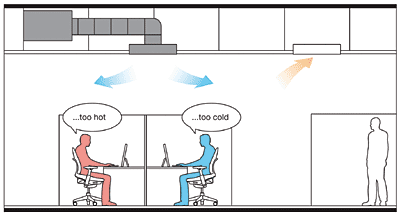Raised Access Floors: The Foundation of Flexibility and Efficiency
Load Ratings and Surface Type: Access floors are categorized or referenced by their load ratings and/or surface type. Floors are referred to in terms of concentrated load rating, with 1,000, 1,250, or 1,500 pounds; and finished surface type, for bare or HPL.
For example, a high-pressure laminate floor panel with a 1,000 pound load capacity is referred to as a "1,000-pound HPL." Similarly, a bare panel with a 1,250 pound load rating is referred to as a "1,250-pound bare."
The various types of load testing used by the Ceilings and Interiors Systems Construction Association to determine panel load capacity (Figure 1 − Access Floor Load Testing) are based on "Recommended Test Procedures for Access Floors" published by the Ceiling & Interiors Systems Construction Association (CISCA).
|
Advantages of Using an Access Floor
There are six main advantages to using access floors.
1. Higher quality underfloor air distribution
compared to overhead air distribution.
In order to understand the differences, an examination of
both traditional overhead air distribution and underfloor
air distribution is in order.
Overhead air distribution: Traditionally, in commercial and institutional environments, conditioned supply air is delivered into an occupied space through ductwork and diffusers spaced evenly in the ceiling overhead. Prior to reaching individuals within the space, the supply air is mechanically mixed, making it uniform in both temperature and pollutant distribution. Just as the supply air is delivered at the ceiling level, so too, the return air is often collected at the ceiling and exhausted through the plenum that is created in the space between the suspended ceiling and the structure above. This common method of conditioned air distribution has resulted in a few well-known issues, however (Figure 2-Traditional Overhead Air Distribution Issues):
|
- Air quality: When heated air rises, it also carries dust particles (pollutants) up toward the supply air ceiling diffusers. Then, in turn, the pollutants are pushed back into user occupied space by the supply air. This can contribute to a build-up of poor air quality in the space.
- Temperature control: Because the mixed air is uniform in temperature, there is usually no opportunity for user adjustment or control. This results in the single most common occupant complaint that the air temperature is either too hot or too cold.
- Energy use: Because warmed air naturally rises, more energy is required to push cooler, conditioned air down into the user zone. Thus, air needs to be cooler than otherwise desired to overcome the hot air barrier so that it reaches users at the necessary comfort level.











